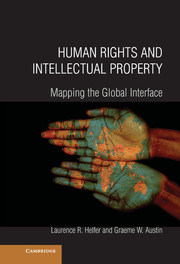Book contents
- Frontmatter
- Contents
- Preface
- 1 Mapping the Interface of Human Rights and Intellectual Property
- 2 The Human Right to Health, Access to Patented Medicines, and the Restructuring of Global Innovation Policy
- 3 Creators' Rights as Human Rights and the Human Right of Property
- 4 Rights to Freedom of Expression, to Cultural Participation, and to Benefit from Scientific Advancements
- 5 The Right to Education and Copyright in Learning Materials
- 6 The Human Right to Food, Plant Genetic Resources, and Intellectual Property
- 7 Indigenous Peoples' Rights and Intellectual Property
- 8 Conclusion
- References
- Acknowledgments
- Index
- Cases Discussed (Selected)
2 - The Human Right to Health, Access to Patented Medicines, and the Restructuring of Global Innovation Policy
Published online by Cambridge University Press: 05 June 2012
- Frontmatter
- Contents
- Preface
- 1 Mapping the Interface of Human Rights and Intellectual Property
- 2 The Human Right to Health, Access to Patented Medicines, and the Restructuring of Global Innovation Policy
- 3 Creators' Rights as Human Rights and the Human Right of Property
- 4 Rights to Freedom of Expression, to Cultural Participation, and to Benefit from Scientific Advancements
- 5 The Right to Education and Copyright in Learning Materials
- 6 The Human Right to Food, Plant Genetic Resources, and Intellectual Property
- 7 Indigenous Peoples' Rights and Intellectual Property
- 8 Conclusion
- References
- Acknowledgments
- Index
- Cases Discussed (Selected)
Summary
Introduction
No other issue so clearly epitomizes the clash between human rights and intellectual property as access to patented medicines. And with good reason. The idea of withholding livesaving drugs from individuals suffering from fatal or debilitating diseases when the means exist to distribute those drugs cheaply and effectively is anathema to all notions of morality. Yet medical treatments such as new pharmaceuticals do not fall from the sky. They are the product of years or even decades of painstaking research, much of which yields little if any therapeutic benefit. If providing widespread access to new medicines were to choke off this research, the results would be less medical innovation and fewer treatments for future diseases – results surely incompatible with the spirit if not the letter of the international human rights regime.
The compatibility of patent protection with access to lifesaving drugs is thus inextricably linked to how societies allocate resources to medical innovation. Governments can provide such resources directly, for example through government-funded research or grants from the public fisc. They can also provide indirect incentives for research through a system of patent protection. In the latter case, private actors – most notably pharmaceutical companies – recoup their research costs and earn a profit through what in most countries is a twenty-year monopoly over the sale, licensing, and distribution of medical inventions. In addition to these private gains, intellectual property-based systems of medical innovation provide numerous social benefits.
- Type
- Chapter
- Information
- Human Rights and Intellectual PropertyMapping the Global Interface, pp. 90 - 170Publisher: Cambridge University PressPrint publication year: 2011



